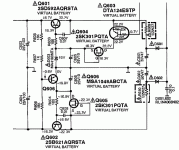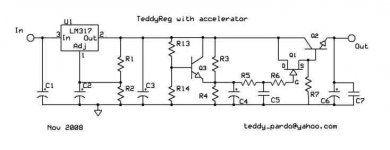2. Bipolar transistors require a large electrolytic cap on the output, and this could be easily detected in listening tests. That is why I now use fets for followers, rather than bipolar transistors, for my best designs.
Hmmm … I just finished a PCB layout with such a "regulator", except that it has a bipolar as the follower portion (instead of several JFETs) and ONLY a small film bypass instead of an electrolytic cap. Are you telling me that I need to go back and change it again?

P.S.Why would I need the big electrolytic with the bipolar follower?
isn't odd that some experts around here keep saying that 16/44.1 is adequate for audio signals? and resort to pseudo science to prove they are right.PMA said:To use different filter, you need sampling higher than 44.1
Your ears, my ears and many other pairs of ears are telling our brains that 16/44.1 does not reproduce audio sufficiently accurately.
john curl said:
It is true that the output impedance is relatively high, BUT it is linear, quiet, and consistent in impedance over a wide frequency range.
And of course, it doesn't impact the sound. But copper vs. silver wiring and Bybee devices do, isn't it?
AndrewT said:isn't odd that some experts around here keep saying that 16/44.1 is adequate for audio signals? and resort to pseudo science to prove they are right.
Your ears, my ears and many other pairs of ears are telling our brains that 16/44.1 does not reproduce audio sufficiently accurately.
I respect your opinion, but I don't share it. Please point out the psuedo-science in any of my arguments? Even some diehard members of the wire listening crowd like Michael Fremmer have on occasion written glowing reviews of 16/44.1 CD's (he put me onto the small Waterlily lable).
I work with people in our digital audio group who share your opinion and some who don't, we all get along.
isn't odd that some experts around here keep saying that 16/44.1 is adequate for audio signals? and resort to pseudo science to prove they are right. Your ears, my ears and many other pairs of ears are telling our brains that 16/44.1 does not reproduce audio sufficiently accurately.
Only if you assume that you can perfectly sample (and reconstruct) the original signal anywhere near ½ Fs. However, this may not be the case if the signal – e.g. 20 KHz spectral component - is not exactly in phase with the sampling clock, and/or where the signal amplitude varies over time (which happens to be the case in real music).
There is an interesting set of arcticles (unfortunately in German) where the author presents a modified sampling theorem and in which he postulates that you need a much higher sampling frequency – he derives at 125,66 kHz needed to represent a 20KHz signal component with less than 1dB error: http://www.omtec-audio.de/fue/feart/feart_6.shtml
Joshua G should have seen A Real Vendetta thread of this forum with complete schematics ,including first stage regulator he eventually has got after too many versions. Voltage reference with constant current and resistors is described in many older electronic books. 2SK170 is not best solution for CCS, since it is a high gm device. I select J-fets with 5ma idss and combinaton of resistor and preset pot. for R2. It is much easier to adjust voltage value in this way. Low noise BJT could be used instead of J-fets for pass transistors.
😕a modified sampling theorem
hopefully the author knows a good dentist. He might 'bite his teeth out' on that sampling thing!
regards
Syn08 - thank you!
If you have the noise data on paper, I can do the transfer from paper to Excel. Just email me the raw data.
Sigurd
If you have the noise data on paper, I can do the transfer from paper to Excel. Just email me the raw data.
Sigurd
syn08 said:
I got BL. There's little physical reason why GR should have lower noise.
I have at hand the Idss dispersions for both 300x2SK170 and 300x2SJ74. For the noise, I still have to process the data manually, I couldn't automatize the data aquisition.
Re: Re: lessons about high performance/low noise regulators
Walt Jung has written an article called
"Don't shun the shunt regulator" and is published in
Electronic Design 14, July 5, 1969.
Sigurd
Walt Jung has written an article called
"Don't shun the shunt regulator" and is published in
Electronic Design 14, July 5, 1969.
Sigurd
Speedskater said:
I'm not sure if his two recent articles on regulators cover shunt regulators, but he writes on more than just current regulators.
http://www.audioxpress.com/magsdirx/ax/addenda/media/jung2778.pdf
http://www.audioxpress.com/magsdirx/ax/addenda/media/jung2779.pdf
Sigurd, if you would only use Toshiba's own noise curves, you would be way ahead in the game.
syn08 said:
Joshua, with John's friendly support, beat you hands down with his outstanding design. You'd better burn your credentials and hide in the woods after this!
And FWIW what is the load regulation? 😀
I'm not an engineer and I don't pretend to be one.
I feel no shame in learning from others and being assisted by others.
Even if I had an engineering title, I wouldn't feel shame to learn from others.
Anyhow, all my final designs will say: "Inspired by John Curl" – and I'd be proud to say it.
There is a Zen saying:
"If you meet Buddha on the road, kill him".
Do you know why?
Originally posted by john curl
This regulator that Joshua_G has designed,
With your blessed assistance.
Originally posted by john curl
I use a Nichicon Muse or equivalent electrolytic cap in order to not have any magnetic leads on the cap(s) as well.
Thank you.
I have some Nichicon Muse caps.
I'm well aware of the importance of selecting ALL parts.
AndrewT said:Idss of the k118 and the value of R1 determine the voltage on the gates of the k170s.
Indeed.
MRupp said:
Hmmm … I just finished a PCB layout with such a "regulator", except that it has a bipolar as the follower portion (instead of several JFETs) and ONLY a small film bypass instead of an electrolytic cap. Are you telling me that I need to go back and change it again?
You mean something like the TeddyReg?
Attachments
syn08 said:
And of course, it doesn't impact the sound. But copper vs. silver wiring and Bybee devices do, isn't it?
Let me see you design an audio gear that get universal approval before you criticize.
tvi said:Joshua_G's reg started to reminded me of Technics' Virtual Battery Operation. They have/had a patent.
The similarity is only in your imagination.
Joshua_G said:
Anyhow, all my final designs will say: "Inspired by John Curl" – and I'd be proud to say it.
And, of course, that's all you care about
 . Real performance (line and load regulation, output impedance, etc...) is for real engineers only, isn't it?
. Real performance (line and load regulation, output impedance, etc...) is for real engineers only, isn't it?- Status
- Not open for further replies.
- Home
- Amplifiers
- Solid State
- John Curl's Blowtorch preamplifier


